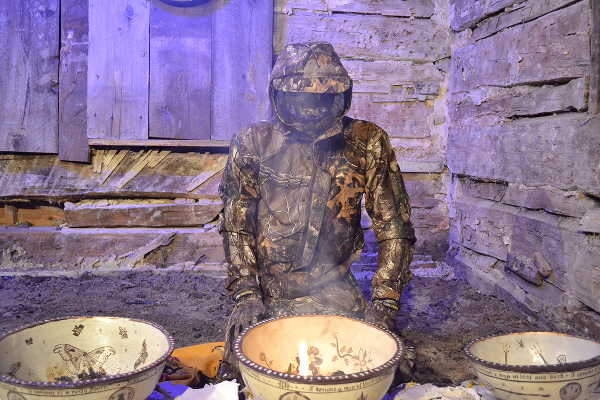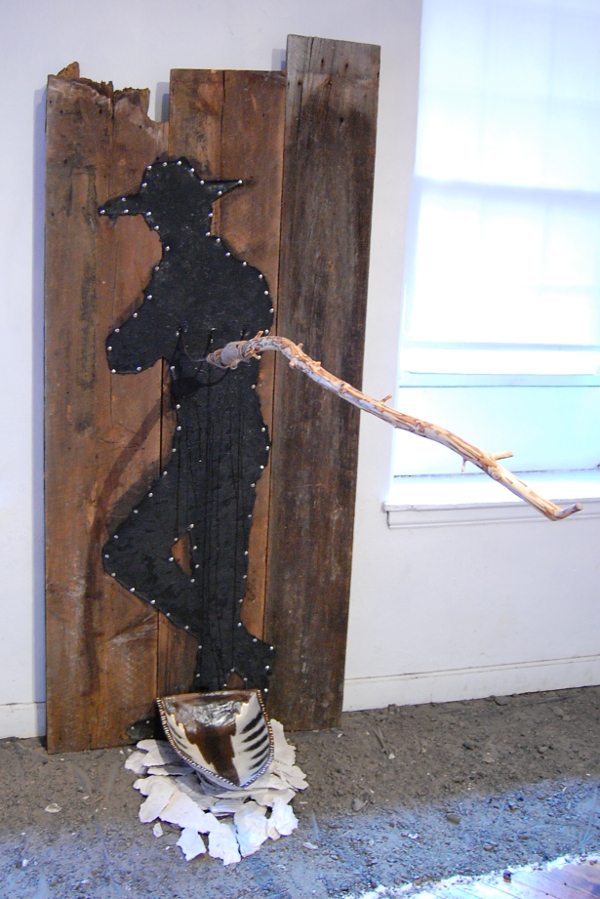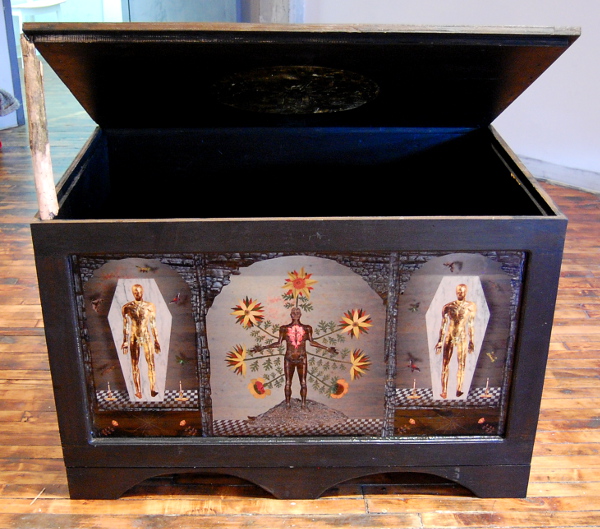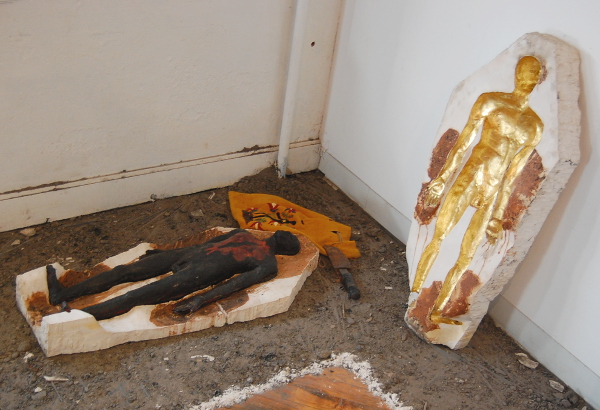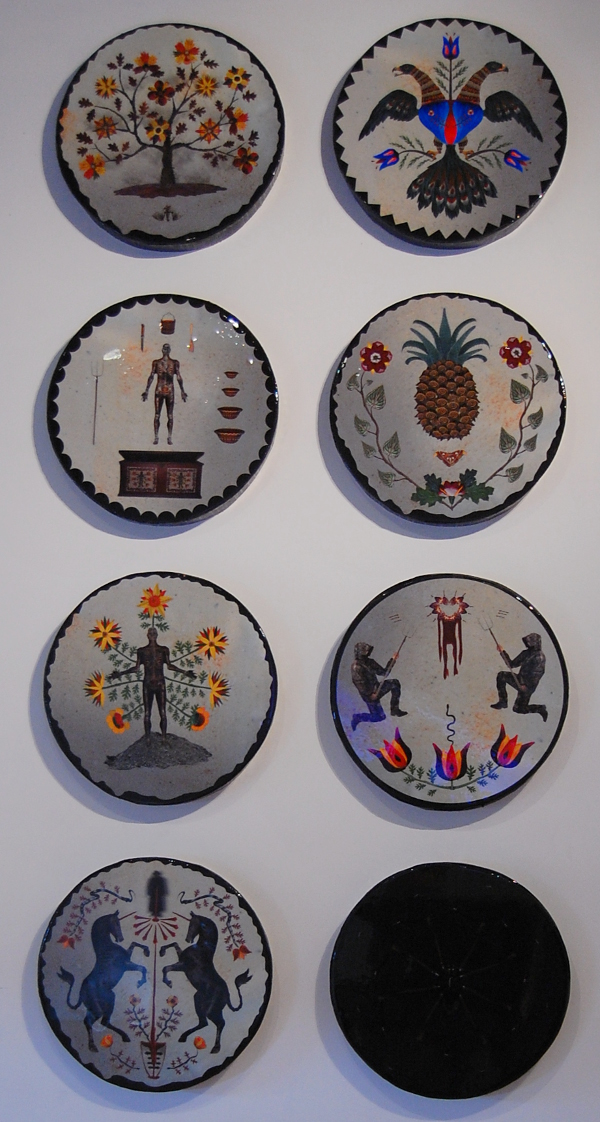
Art of the hex and finding meaning in secular magic with Nick Lenker
Shamanistic rituals filled with enigmatic symbolism are occurring at Practice Gallery in the most fancy of ways: Fancy Dutch ways. Anyone familiar with the Pennsylvania Dutch (German) immigrants that populated many parts of the Keystone State through the 17th and 18th centuries might also know about their patterned ceramics or their kaleidoscopic hex signs. But to what extent are these images more than merely things of beauty? Nick Lenker completely immerses himself in the local lore for his show “Long Hidden Friend,” and the result is a profound mystical rite as much historical fiction as personal history.
In two columns running down the far wall, we find a series of what appear to be glossy hex signs that represent one the most enduring and recognizable visual traditions from Pennsylvania Dutch country. Even today, a casual drive around Eastern Pennsylvania will reveal these colorful, painted mandalas hanging on the sides of barns, sheds or houses. Although outwardly just folk art intended to enliven farmland, hex signs derive their name from ‘die Hexe,’ the German word for ‘witch.’ Many of the popular designs are also emblematic of certain hopes or wishes; talismans to bring about health, good fortune or virtue. Lenker takes this symbolism very much to heart in both his performances as well as the objects he crafts.
By utilizing a lexicon that references original hex signs, but also includes his own personal narrative, Lenker places unicorns, flowers and birds common in the work of German-American artists alongside pineapples, anatomical depictions and characters of his own creation. The result is a summoning that is simultaneously supernatural and secular, deeply rooted in the traditions of the past but also ineffably personal. We are consequently split between humanism and healing herbs, magical incantations and the digital world we live in today. Lenker’s smoke and mirrors, however, seem to intentionally keep the empiricism at bay.
A still from the video of “Long Hidden Friend” by Nick Lenker. Image courtesy of Practice
Across from the signs, a video projection loops a scene from an eerie wooden interior with a sooty floor in which a disguised figure goes about the conjuring as if alone and not in front of a camera. The figure is in a head-to-toe camouflage hunting jumpsuit with a hood. Where a face would be, we find only a curved mirror rendering this being utterly anonymous and genderless. Presumably, the only thing visible by looking at this visor is oneself, provoking an introspective ego trip as the other goes meticulously about the ritual at hand.
The silhouetted figure from the beginning of the ceremony, pitchfork still stabbed firmly in place.
With only the subject’s appearance as the forgotten redneck member of Daft Punk offering any overt humor, the process we witness is otherwise quite somber. The figure begins by creating and stabbing a human silhouette with a pitchfork, collecting the black liquid that spurts forth, crushing a horse doll in it, lighting a fire, and generally putting a curse on… something. All of this action takes place in a series of ceramic Fraktur bowls that resemble those originating in Pennsylvania Dutch folk art, parallel to the hexes that fill the screen to precede each occult interlude.
A chest which contains the earthenware bowls in which the rituals are performed.
The name of the show itself is an interpretation of an 1820 book of herbal medicine and magical prayers entitled “The Long-Lost Friend,” while the obscure inscriptions on an earthenware plate found in the Philadelphia Museum of Art seem to guide the rest of the liturgy. Speaking vaguely of sincerity, emotions and the devil, an uninformed outsider would be just as vexed by the antique text as by Lenker’s highly precise, yet shadowy rites.
One of the final acts is one of creation, in which the disguised figure reveals the cast form of a man.
Perhaps like the shamans of old, or a contemporary psychedelic seeker, the processes here are meant to remain straddling the personal and the universal in a way that keeps the revelations just out of reach. Regardless, the alien ceremony culminates in the casting and revealing of the tiny, black body of a man from between two halves of a stony mold. All of the artifacts from the video also populate the gallery space while the performance plays, adding a physicality to the projections of light.
Is Lenker playing god? Is he making himself along the way or just shaping our perceptions? The camouflaged priest remains silent and steel-faced through it all, and we are left with a roomful of symbols that we must reckon with alone. It is almost as if the visitors to “Long Hidden Friend” were never truly meant to witness the dark service inside the chilly, wooden barn. Armed with only our observations, we must depart this realm of not-quite-fiction and go back into the world where the hex is merely a sign and our rhythms and daily rituals are, if not mundane, benign. The exhibit will be on display through November 1.
Practice is located at 319 North 11th St., on the 2nd floor, Philadelphia; [email protected]; practicegallery.org.
Recent Content
-
Artsarticle ·
-
Artsarticle ·
-
Artsarticle ·
